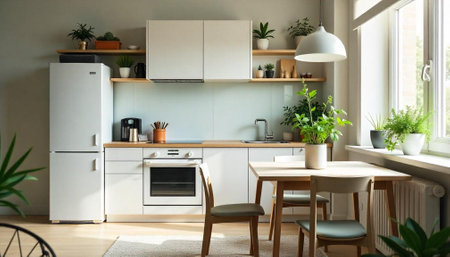Introduction to Layered Lighting and Sustainability
Layered lighting is an essential design principle in British interiors, combining multiple sources of light to create balanced, flexible, and inviting spaces. Rather than relying on a single overhead fixture, layered lighting integrates ambient, task, and accent lighting to cater for different moods and activities throughout the day. In the context of UK homes—where changing daylight, variable weather, and often compact room sizes play a significant role—this approach not only enhances comfort but also helps make the most of each space.
However, as environmental awareness grows across the United Kingdom, there’s a pressing need to adopt sustainable practices within our homes. Incorporating sustainability into layered lighting means considering energy-efficient technologies, responsibly sourced materials, and thoughtful design that reduces waste. This is particularly relevant given the UK’s ambitious climate goals and the increasing focus on reducing household carbon footprints. By marrying traditional British aesthetics with modern eco-conscious choices, homeowners can create interiors that are both charming and kind to the planet.
Understanding British Home Lighting Traditions
When considering sustainable practices in layered interior lighting, it’s essential to first appreciate the longstanding traditions that shape lighting in British homes. The evolution of home lighting in the UK reflects a blend of historical influences, practical needs, and cultural preferences. From Georgian townhouses to Victorian terraces, traditional British interiors have always embraced both function and atmosphere.
Historically, natural daylight played a pivotal role, with large sash windows designed to maximise sunlight during short winter days. In the evenings, candles and oil lamps provided soft, ambient illumination. With the advent of electricity in the late 19th century, homes began incorporating ornate chandeliers and wall sconces—fixtures that remain popular in many period properties today.
The table below outlines some common traditional lighting fixtures found in British homes and their typical uses:
| Fixture Type | Common Placement | Historical Notes |
|---|---|---|
| Chandelier | Entrance halls, dining rooms | Symbol of elegance since Georgian era; often used as statement pieces |
| Wall Sconce | Corridors, living rooms | Originally candle-based; adapted for electricity while retaining classic shapes |
| Table Lamp | Bedside tables, lounges | Became widely popular in Edwardian period; valued for portability and warmth |
| Pendant Light | Kitchens, stairwells | Used for focused task lighting; seen in both modern and period renovations |
| Picture Light | Above artwork or mirrors | Evolved from Victorian interest in art display; highlights features without glare |
This layering of different light sources—each with its own character and purpose—creates a distinctive British aesthetic that balances practicality with comfort. Recognising these traditions is key to respectfully integrating new eco-friendly approaches that complement existing styles rather than replacing them outright. By understanding what has worked well historically, homeowners can make informed choices about updating their lighting schemes to be more sustainable without losing the charm and heritage unique to British interiors.
![]()
3. Eco-Friendly Lighting Technologies
When it comes to sustainable layered lighting in British homes, energy-efficient technologies are truly changing the game. LED bulbs, for instance, have become a staple for those wishing to reduce both their carbon footprint and their electricity bills. These bulbs not only last significantly longer than traditional incandescent options but also come in a range of colour temperatures, making it easy to create inviting layers of light throughout your living space.
For those who enjoy a bit of modern convenience, smart lighting systems offer an innovative way to maximise energy savings. Systems like Philips Hue or Hive Active Lights allow UK homeowners to tailor brightness levels and timing schedules via smartphone apps or voice assistants, ensuring that lights are never left on unnecessarily. This type of automation is especially handy in multi-layered lighting schemes, where you might want different ambiences at various times of day.
It’s worth noting that supporting sustainability goes beyond just the products themselves; choosing local suppliers plays a key part in reducing transport emissions and supporting the UK’s green economy. Many British lighting retailers now stock products from brands committed to ethical sourcing and environmentally-friendly manufacturing processes. By opting for these local options, residents can layer their interiors with a sense of environmental responsibility as well as style.
4. Practical Strategies for Layered Sustainable Lighting
Creating a sustainable and inviting lighting scheme in British homes is all about understanding the unique features of UK architecture—from Victorian bay windows to snug terraces and modern flats. Here’s how you can blend eco-conscious choices with layered lighting to suit both the character of your home and your daily routines.
Ambient Lighting: Setting the Foundation
Start with energy-efficient ceiling lights or wall-mounted fixtures that softly illuminate the entire space. Opt for LED bulbs with a warm white colour temperature (around 2700K–3000K) to create that classic British cosiness, especially during those long winter evenings. Consider dimmer switches or smart lighting controls to fine-tune brightness according to mood and need, helping save energy while keeping things snug.
Task Lighting: Focused and Flexible
In kitchens, home offices, or reading nooks, targeted task lighting is essential. Use adjustable desk lamps or under-cabinet LEDs—these direct light precisely where needed, reducing glare and energy waste. For period properties with quirky corners or alcoves, clip-on lights or plug-in wall lamps offer flexibility without permanent wiring changes.
Accent Lighting: Highlighting Character
Accent lighting brings out the best in architectural features like exposed brickwork, cornices, or cherished artwork. Try LED picture lights, subtle uplighters behind furniture, or even fairy lights along mantelpieces for a touch of whimsy. Select fixtures made from recycled materials or vintage finds sourced locally; these add charm while supporting sustainability.
Quick Reference: Layered Lighting Essentials
| Layer | Recommended Fixtures | Sustainable Tips |
|---|---|---|
| Ambient | Pendant lights, flush ceiling lights, wall sconces | LED bulbs; dimmers; timers |
| Task | Desk lamps, under-cabinet strips, floor lamps | Directional LEDs; plug-in options for flexibility |
| Accent | Picture lights, uplighters, fairy lights | Energy-saving bulbs; upcycled/vintage fixtures |
Tackling British Home Quirks Sustainably
If your property has low ceilings or small windows typical of older UK homes, use mirrors opposite windows to bounce natural light deeper into rooms and reduce reliance on artificial sources during the day. In rental flats where rewiring isn’t possible, portable smart bulbs and adhesive strip lights provide adaptable solutions without leaving marks—ideal for both sustainability and easy removals.
5. Repurposing and Upcycling Lighting in the British Home
Embracing sustainability in layered interior lighting doesn’t have to mean sacrificing style or comfort. In fact, repurposing and upcycling lighting offers British homeowners a unique opportunity to create characterful, eco-conscious spaces while reducing waste. Instead of discarding outdated or tired light fixtures, consider giving vintage lamp bases a new lease of life. These often possess a charm that modern mass-produced alternatives can’t replicate, and with a simple update—such as rewiring for safety or fitting with an energy-efficient bulb—they become both sustainable and stylish.
Incorporating Upcycled Materials
When thinking about layered lighting, look beyond traditional lamps and pendants. Get creative by incorporating upcycled materials into your lighting design. For example, glass jars from the kitchen cupboard can be transformed into quirky pendant lights, while reclaimed wood may serve as a rustic base for table lamps. Even old teacups—a nod to quintessential British culture—can be cleverly converted into whimsical wall sconces. These projects not only minimise environmental impact but also make for great conversation starters when guests visit.
Supporting Local Charity Shops and Makers
A sustainable approach also means supporting the local community. Charity shops across the UK are treasure troves for preloved lighting pieces and materials waiting for a second chance. By choosing these options over new purchases, you help reduce landfill waste and support charitable causes at the same time. Similarly, many local makers specialise in upcycled or handmade lighting solutions. Opting for their creations fosters craftsmanship, reduces transport emissions associated with mass production, and injects your home with one-of-a-kind appeal.
Sustainable Living as a Mindset
Ultimately, repurposing and upcycling lighting is about adopting a sustainable mindset—one that values creativity, resourcefulness, and community connection. Each reused lamp base or upcycled shade is a small step towards a more environmentally friendly layered lighting scheme, perfectly suited to British homes seeking comfort without compromise.
6. The Everyday Benefits of Sustainable Lighting Choices
Making sustainable lighting choices in British homes isn’t just about saving energy—it’s about enriching daily life. Thoughtfully layered lighting can elevate your home environment, offering tangible benefits that you’ll notice every day. By combining ambient, task, and accent lights with energy-efficient technologies, homeowners across the UK can create spaces that feel welcoming and comfortable all year round.
Boosting Wellbeing Through Better Lighting
Natural-feeling, well-placed light supports wellbeing by mimicking the rhythms of daylight, which is especially valuable given the often-grey British weather. Smart use of dimmable LEDs, daylight bulbs, and strategic window placement can help combat winter gloom and support healthy circadian rhythms. A carefully lit living space encourages relaxation in the evenings while bright, focused task lighting helps you stay productive in home offices or kitchens.
Savings That Add Up
Switching to energy-saving bulbs and using layered lighting where each zone serves a clear purpose means you only use as much light as you need. Over time, this translates into noticeably lower electricity bills—something every household appreciates as energy costs fluctuate. Timers, sensors, and smart controls let you avoid lighting empty rooms or over-illuminating spaces, making your home more efficient without sacrificing comfort.
Seamlessly Fitting Into Daily Life
Sustainable lighting choices integrate effortlessly into typical British routines. For example, motion sensors in hallways make late-night trips safer and more convenient for families. Layered lighting in sitting rooms allows everyone to enjoy reading nooks or movie nights without harsh overhead glare. These practical touches enhance daily life while keeping sustainability at the forefront.
Mindful Maintenance Tips
To keep your sustainable lighting working its best, regular maintenance is key. Dusting lampshades and fixtures maximises brightness and extends bulb life. Periodically checking fittings ensures there’s no wasted energy from loose connections or outdated technology. Keep a small stock of replacement LED bulbs on hand so you’re never tempted to pop in an old incandescent when one goes out.
Reducing Light Pollution Locally
A truly sustainable approach also considers your neighbours and local wildlife. Use blackout blinds or curtains in bedrooms to prevent unnecessary glow spilling outside at night. Choose outdoor fixtures with shielded designs to focus light downward rather than letting it drift skyward—helping preserve the beauty of a dark British sky and supporting nocturnal wildlife.
By embracing these sustainable practices in layered interior lighting, British homeowners can enjoy brighter days (and cosier nights), save money, and play their part in protecting the environment—all while living comfortably and stylishly.
7. Conclusion: Embracing Sustainable Lighting for a Greener Future
As we draw our exploration of sustainable layered lighting for British homes to a close, it becomes clear that small, thoughtful changes can make a remarkable difference. By blending traditional British charm with innovative, eco-friendly solutions, you don’t have to sacrifice style or comfort for sustainability. Whether you’re swapping out bulbs for energy-efficient LEDs, investing in smart controls, or simply rethinking how you use natural daylight, each step contributes to a greener future. Embrace layered lighting by mixing ambient, task, and accent sources—each carefully chosen not only for visual appeal but also for their environmental impact. Remember, the journey towards sustainable living is about progress, not perfection; even modest adjustments in your everyday routines and design choices add up over time. So as you look around your home, consider how a mindful approach to lighting can reflect both your personal taste and your commitment to the planet. Together, these manageable steps light the way towards a stylish, welcoming home that truly supports a more sustainable Britain.


